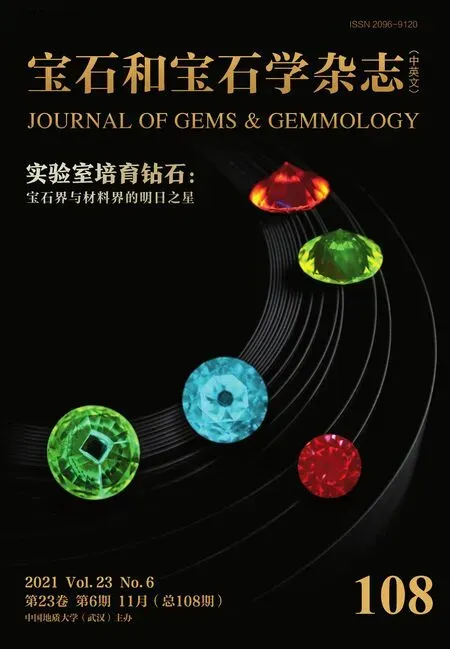Laboratory-Grown Diamond: A Gemological Laboratory Perspective
Sally Eaton-Magaa,Troy Ardon, Christopher M.Breeding
(Gemological Institute of America, Carlsbad 92008,USA)
Abstract:This article provides an overview of the laboratory-grown diamonds seen at GIA over the last 15 years.During that time, the diamond industry has witnessed an exponential increase in the quantity and quality of laboratory-grown diamonds and, therefore, these products’ ability to be commercialized on a large scale.It presents a brief summary of the HPHT and CVD growth processes and then explores some of the major trends observed since GIA began providing synthetic diamond grading reports in 2007.These trends include the shift towards larger and colorless stones.It also shows a shift towards CVD diamonds dominating the supply of laboratory-grown diamonds submitted for grading reports and that the majority of these have been subjected to post-growth HPHT treatment.In addition, we briefly discuss some methods and strategies used for identification such as the distinguishing gemological characteristics and some recent approaches in advanced testing.Finally, we present an array of laboratory-grown diamonds that are currently unusual, however, these may become more common in the future.
Key words: HPHT-grown diamond; CVD-grown diamond; 4Cs, diamond melee; fancy colored diamond
INTRODUCTION
Laboratory-grown diamonds have complicated the trade for diamond gemstones, but they have also expanded the range of products available on the market.Colorless to near-colorless laboratory-grown diamonds have many gemological properties and an appearance that are consistent with natural diamonds(Fig.1),therefore, they have created a new challenge for many gemologists and appraisers to correctly separate these two groups.As a result, gemologists have needed to either purchase additional testing equipment to conduct the identification themselves or to rely more on gemological laboratory for the correct determination.Many gemological laboratories possess the necessary equipment for reliable assessment of laboratory-grown diamonds.Since colorless to near-colorless laboratory-grown diamonds are type Ⅱ, which constitute only a small percentage of the population of natural diamonds, this limits the number of potential diamonds that require extensive analysis to only a small fraction.
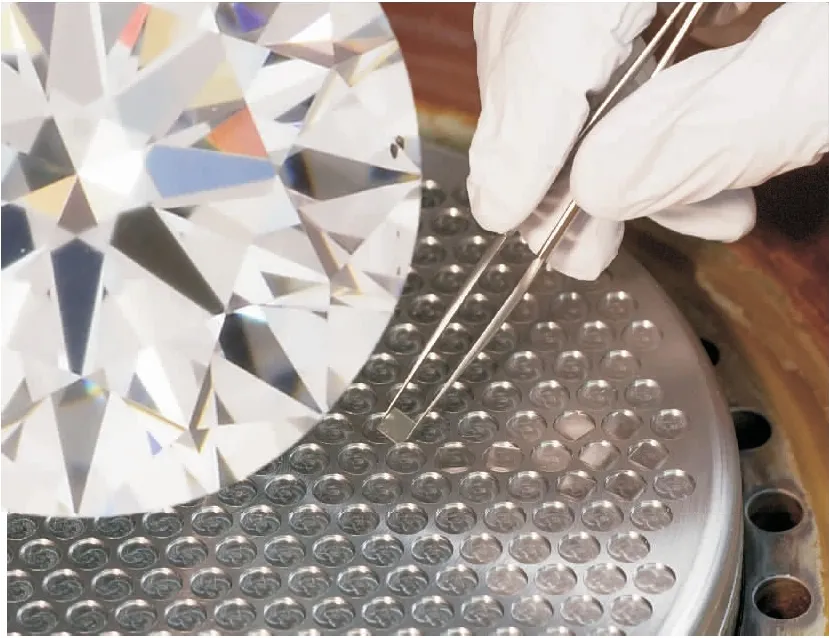
Fig.1 Laboratory-grown diamonds have become an important sector of the gem diamond trade.The background image illustrates that many CVD-grown diamonds may be manufactured simultaneously by using multiple seed plates within the reactor.© Fraunhofer IAF.
An additional and notable complication in recent years has been the dramatic increase in melee-sized HPHT-grown diamonds.These stones can easily, and perhaps unknowingly, be mixed with their natural counterparts.
In this article, we wish to summarize the types of products submitted to GIA over the years and to allow the HPHT-and CVD-grown diamonds to speak for themselves.The story of the evolution of gem-quality laboratory-grown diamonds can be persuasively told through chronicling the changes that have been seen over the last 15 years.Additionally, we highlighted some emerging laboratory-grown products that may be seen in greater numbers in the future.
HPHT Growth
There are two major growth methods for producing gem-quality synthetic diamond.The high-pressure, high-temperature(HPHT)method approximates the conditions required for diamond growth within the earth.Pressures of 5-6 GPa(equivalent to 150-190 km depth in the earth)and temperatures of 1 300-1 600 ℃ are used.The growth temperatures are a few hundred degrees hotter than for natural diamond, which facilitates faster diamond growth.The growth occurs in a capsule that contains a carbon source, a metallic flux to dissolve the carbon to facilitate growth, and a diamond seed to start the growth.The seed diamond is kept at a lower temperature to allow the crystallization to occur only on the seed.Typically, an HPHT-grown diamond can be grown in an hour to a few weeks depending on the desired size.
Although CVD growth of diamond predates HPHT growth(Angus, 2014), the HPHT growth method has a longer history among gem-quality diamonds(Shigley et al., 2002; Shigley et al., 2004).Most of the early products were fancy color, particularly yellow-orange to yellow due to isolated nitrogen impurities or blue due to boron incorporation.During the last decade, colorless to near-colorless products have become common(D’Haenens-Johansson et al., 2014; Eaton-Magaa et al., 2017)and within the last five years, large-sized HPHT-grown diamonds greater than 10 carats have been reported(Deljanin et al., 2015; D’Haenens-Johansson et al., 2015a).Recently grown HPHT crystals have exceeded 100 carats(“Meylor Global…”, 2020).
CVD Growth
The other major growth technique is chemical vapor deposition(CVD).This method requires a reaction chamber in which microwaves form a plasma; This plasma consists of hydrocarbon fragments from the hydrogen and methane feed gases.A large amount of hydrogen, up to 99% of the feed gas, is required to remove any graphite or non-diamond carbon that can grow on the surface of the diamond which would interrupt growth.Through a complex sequence of events, carbon attaches itself to the growing surface, forming new diamond layer by layer, and effectively “photocopying” the structure below.Fig.2 shows a time-lapse series of images inside a CVD reactor showing a growing diamond plate.Several crystals can be grown simultaneously, allowing the technique to produce laboratory-grown diamonds at commercial scales.

Fig.2 This photo sequence of a growing CVD sample within the CVD reactor shows the progression in thickness over time.The edges become significantly rougher as non-diamond carbon forms on those surfaces.The red color for the CVD diamond is because the sample is photographed within its growth environment and while at the growth temperature of~1 000 ℃.The initial dimensions of the plate are 7×7 mm.
For several decades after the CVD method was developed, it was not applicable for gem applications or it was only possible in experimental quantities(Wang et al., 2003; Martineau et al., 2004; Wang et al., 2005; Wang et al., 2007; Angus, 2014).In the last 10-15 years, significant improvements in growth procedures(e.g., Butler et al., 2009; Eaton-Magaa and D’Haenens-Johansson, 2012; Nad et al., 2015)now permit commercial quantities of gem-quality CVD-grown diamonds(e.g., Wang et al., 2010; Wang et al., 2012; Eaton-Magaa and Shigley, 2016).
DISTRIBUTION OF LABORATORY-GROWN PRODUCTS
GIA maintains a database of all submitted diamonds, natural, treated, and laboratory-grown, both fancy color and colorless that have been submitted to the laboratory.This permits the helpful opportunity to look at historical data and examine trends that have emerged over the years.Fig.3 to Fig.7 chronicle the results on the many thousands of HPHT-grown and CVD-grown diamonds that have been examined at GIA(Eaton-Magaa and Shigley, 2016; Eaton-Magaa et al., 2017).
Fig.3 shows the color distribution of HPHT-grown diamonds.Yellow-orange samples represent a vast majority of submissions during the early years and constitute a significant portion of all HPHT-grown diamonds cumulatively seen at GIA since 2007 when the synthetic diamond reports were first implemented.As the growth process improved, the manufacturers were able to eliminate nitrogen from the growing diamonds, which was the major cause of that yellow-orange color.In recent years, client submissions of yellow-orange HPHT-grown diamonds have plummeted and been eclipsed by colorless samples.
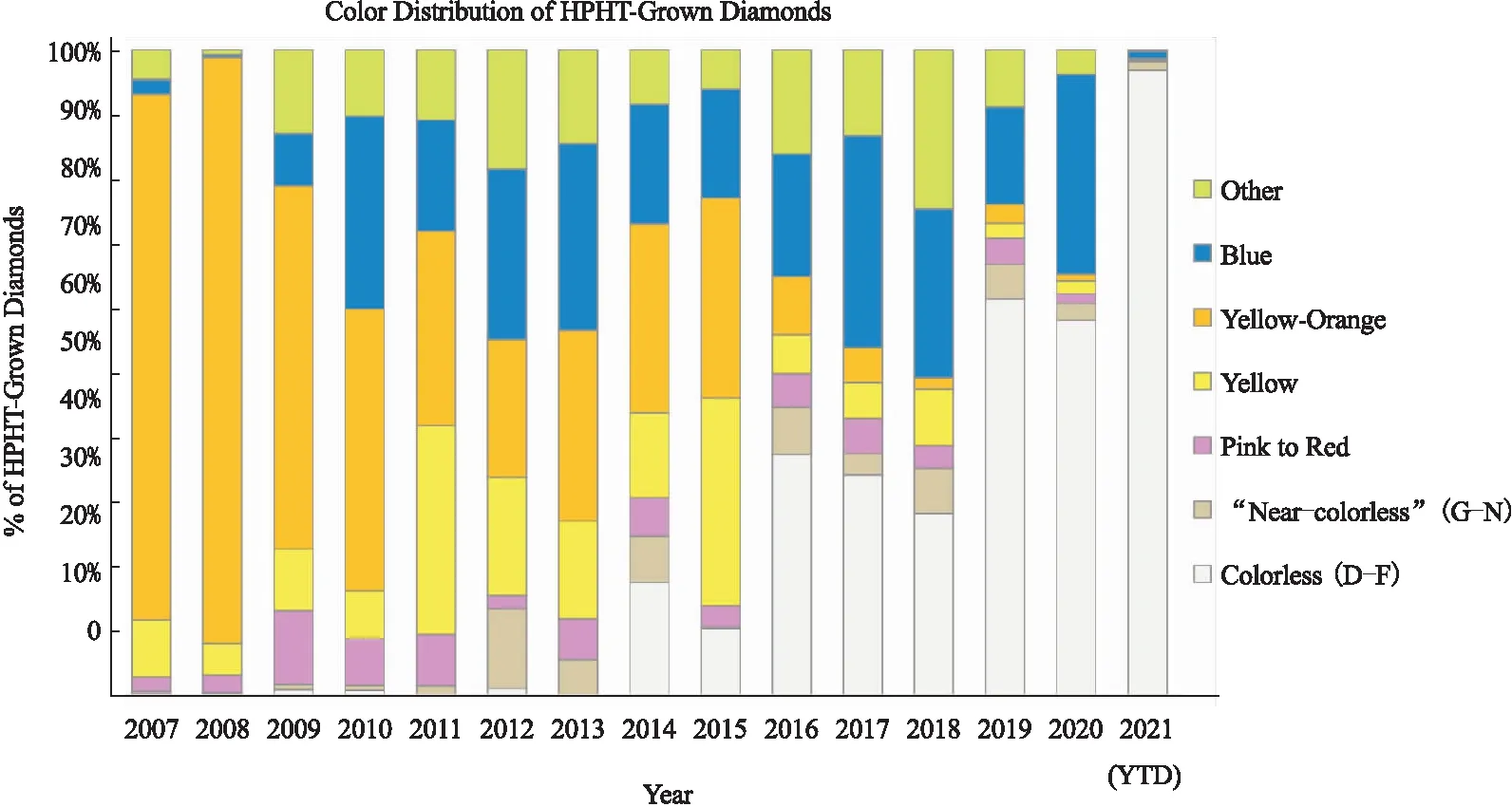
Fig.3 The percentage of HPHT-grown diamonds submitted to GIA in each calendar year beginning with 2007 when synthetic diamond reports were first issued and extending through 2021(year-to-date: January-September)and the color distribution.
The color distribution of CVD synthetic diamonds analyzed by GIA are also chronicled by year(Fig.4).For much of the 2000s, the sample submission was low, so some of those years are combined in the plot.For many years, the majority of diamonds were predominantly “near-colorless” with color grades of G-N.There were few CVD submissions that were in the colorless range.However, in 2020, the percentage of colorless CVD diamonds did increase dramatically, which is likely due to improvements in the growth procedure by some manufacturers.In addition, in the mid-2010s, a notable proportion of CVDs had a gray coloration.This result was likely unintended and related to underlying technological issues.Such conditions that created gray-colored CVD-grown diamonds appear to have been largely eliminated and these are no longer being submitted.
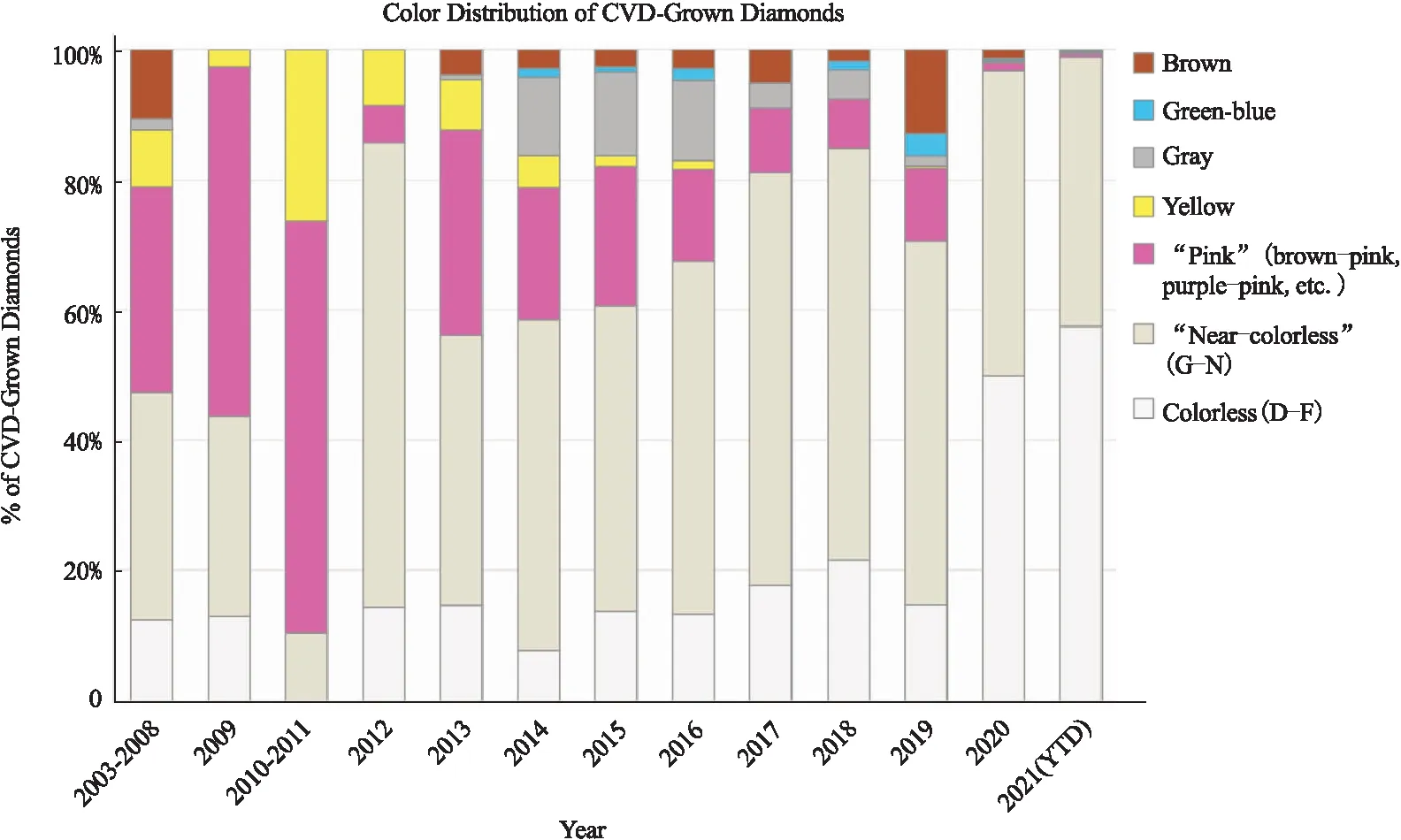
Fig.4 The percentage of CVD-grown diamonds submitted to GIA in each calendar year from 2007-2021(year-to-date: January-September)and the color distinbution.
Fig.5 chronicles the weight distribution in faceted HPHT-grown diamonds by year.In the early years(2007-2009)of synthetic diamond grading reports at GIA, there were a higher proportion of larger-sized goods compared to the early 2010s.Those larger-sized HPHT-grown diamonds were predominantly the less marketable yellow-orange color.As the manufacturers transitioned to more favorable colors(Fig.3), this likely created a temporary reduction in carat size.In the years since, the weight distribution has returned towards larger sizes and now the vast majority are greater than 1 carat.Again, this chart refers to submissions to the GIA laboratory.There are large scale melee-sized HPHT synthetic diamond plants in China that produce hundreds of thousands of carats a month, but these are not issued GIA grading reports.

Fig.5 The percentage of HPHT-grown diamonds submitted to GIA in each calendar year from 2007-2021(year-to-date: January-September)and the weight distribution.
Far more dramatic has been the shift seen in the weights of gem-quality CVD diamonds.There has been a steady increase across the years towards larger sized material(Fig.6).Back in the 2000s, the vast majority of CVDs were less than one-half carat.Now, the majority are greater than 2 carats.
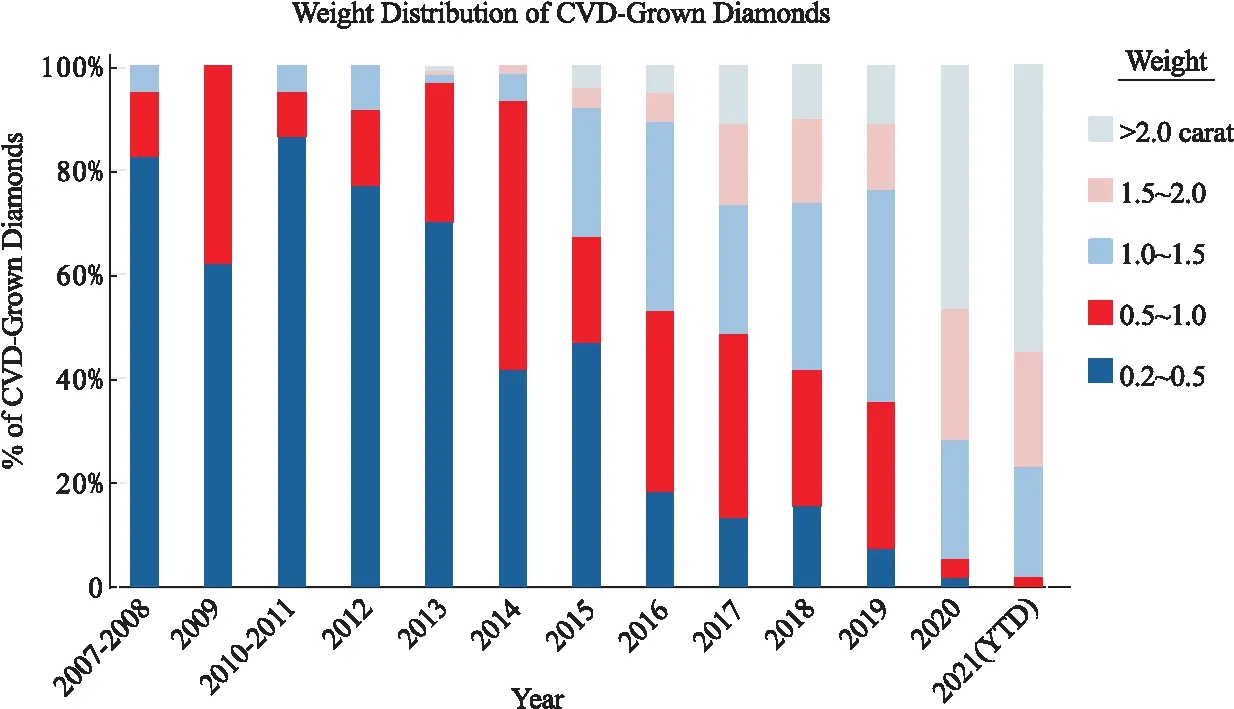
Fig.6 The percentage of CVD-grown diamonds submitted to GIA in each calendar year from 2007-2021(year-to-date: January-September)and the weight distribution.Due to very low submissions during some calendar years, those years have been combined.
Fig.7a shows the proportion of each growth method of laboratory-grown diamonds that have submitted to GIA since 2007.In those early years, the overwhelming majority of synthetic diamonds were HPHT-grown.In the years since, the CVD population has made steady gains and around 2016, CVD became the majority of the submissions.Currently, GIA receives as many CVD-grown diamonds in a single day as were submitted over an entire year in the past.
As with brownish natural diamonds(e.g., Fisher et al., 2009), CVD-grown diamonds can also be treated at high temperature and high pressure to reduce the brown coloration.(Please note that while the same equipment for HPHT treatment can be used as with HPHT growth, these two processes are distinct.Additionally, HPHT treatment generally functions at different temperature and pressure conditions than HPHT growth.)CVD manufacturers know they can grow the diamond layers more quickly with a brown coloration and this brown color can be reduced later through HPHT treatment.
Fig.7b shows the percentage of CVD diamonds that we have seen that show indications of being submitted as-grown and those with evidence of post-growth treatment.Over the years, there has been a general upward trend in the percentage of CVD-grown diamonds showing evidence of HPHT treatment.Overall, the percentage of CVD diamonds seen at GIA with post-growth processing is about 80%.

Fig.7 (a)The percentage of CVD-grown and HPHT-grown diamonds submitted to GIA in each calendar year from 2007-2021(year-to-date: January-September);(b)The percentage of CVD-grown diamonds submitted to GIA in each calendar year from 2007-2021(early years combined).A tiny percentage of CVD-grown diamonds have gemological and spectroscopic features that do not currently permit a treatment designation and receive an undetermined result regarding post-growth treatment,these are not included within the figure.
INSTRUMENTATION AND MELEE DIAMONDS
For many within the diamond trade, the rapid increase in production and the mixing of laboratory-grown diamonds with their natural counterparts has created several identification challenges.While the quantity and growth conditions for HPHT-grown and CVD-grown diamonds have evolved over the years, many of the gemological criteria and strategies have remained the same.Additionally, because of the great distinctions between HPHT and CVD growth methods, along with the different possibilities of post-growth treatment, there is not, as yet, an inexpensive and quick screening instrument that can provide definite identifications.Most of the screening tools(e.g., Tsai and D’Haenens-Johansson, 2019)employ a “pass” or “refer” verdict, those diamonds that “refer” on the screening instruments may be natural or laboratory grown; however, they require additional testing such as gemological analysis(summarized in the next section)or submission to a gemological laboratory.
An underlying premise behind much of the screening, particularly for those that are colorless to near-colorless, relies upon the chemistry of the diamond or the impurities present.This is generally summarized as the diamond type(Breeding and Shigley, 2009; Eaton-Magaa et al., 2020), which is a very useful metric for so much of diamond science and diamond identification.Fig.8 shows the very distinct populations of diamond type that exist within the natural diamond, treated, and the laboratory-grown diamond regimes.Among D-to-N diamonds, 99% of natural diamonds are type Ⅰa, and 100% of colorless laboratory-grown diamonds are type Ⅱ; this separation creates a reliable foundation for many screening strategies.

Fig.8 Distribution of diamond types among colorless to near-colorless diamonds based on origin and treatment history(Eaton-Magana et al., 2020).
For example, fluorescence spectroscopy distinguishes “pass” and “refer” verdicts based on detection of lattice defects that occur in natural diamonds, but which do not occur in laboratory-grown diamonds(e.g., Tsai and D’Haenens-Johansson, 2019).These measurements are tangentially related to diamond type as most of these lattice defects in natural diamond contain nitrogen and nearly all natural diamonds, including type Ⅱa, have those nitrogen-related defects even if those defects are present at very low concentrations.
Melee-sized diamonds pose a distinct identification challenge due to their small size and relatively high abundance compared with larger diamonds.Their small size often makes it difficult to view them within a microscope and they often do not possess identifying inscriptions of the manufacturer or gemological laboratories(Choi et al., 2021).
Those manufactured at HPHT conditions dominate laboratory-grown melee(Eaton-Magaa et al., 2017).They are produced principally by factories in China.A 2018 estimate of rough production wasabout 5 million carats/year(Lu et al., 2019), much of which was likely melee sized.The HPHT-growth method is more conducive to economically growing melee-sized diamonds than the CVD growth method as it permits the production of thousands of near-colorless individual crystals using microscopic-sized seed crystals.
GEMOLOGICAL ASSESSMENT
While a gemological examination may not always be diagnostic to distinguish laboratory-grown diamonds from natural stones, it can be helpful to verify the origin.For example, alaboratory-grown inscription or a manufacturer-specific inscription is often present on the girdle of commercial-sized goods.Additionally, both HPHT-grown and CVD-grown diamonds often show a stronger fluorescence response, when present, to short-wave UV than to long-wave UV.Among natural diamonds, the reverse pattern is usually observed; that is, in natural diamonds, the fluorescence response is more intense to long-wave UV than to short-wave UV.
Note that while some gemological features are strong indicators of a laboratory-grown origin, a combination of gemological features is usually necessary to make an identification.For example, while magnetism is a strong indication that a diamond is HPHT-grown, the lack of magnetism does not preclude this possibility.Also, some rare natural diamonds are magnetic due to natural metal inclusions(Smith et al., 2016).Similarly, a blue-green color of phosphorescence is a common feature among colorless to near-colorless HPHT-grown diamonds.However, rare natural type Ⅱb diamonds and some CVD-grown diamonds can show a similar phosphorescence response.Additionally, the phosphorescence response in HPHT-grown diamonds can be reduced or eliminated though low-dose irradiation(Diamond Services, 2018).Nevertheless, this section summarizes some of the consistently observed gemological features seen in HPHT-grown and CVD-grown diamonds(Eaton-Magaa and Breeding, 2018; Lu et al., 2019).
HPHTLaboratory-GrownDiamond
Several key characteristics help identify HPHT-grown diamonds(Fig.9a).With a microscope, opaque, metallic rod-shaped inclusions or pinpoints(particularly in fancy colored goods)may be observed.HPHT-grown diamonds with a high quantity of metallic inclusions(generally with clarity grades of VS2 or lower; D’Haenens-Johansson et al., 2014)also can show attraction to a magnet.
One of the more reliable methods of determining an HPHT-grown diamond is examining the diamond through crossed polarizers.Unlike natural and CVD-grown diamonds, HPHT-grown samples will have no discernible strain pattern.However, there are the occasional exceptions to this observation(Ardon and Batin, 2016).
Under short-wave UV, HPHT-grown colorless diamonds typically have yellow fluorescence with long-lived strong green-blue phosphorescence.With deep UV, the fluorescence is typically green-blue or green fluorescence with strong green-blue phosphorescence.Additionally, a cubo-octahedral geometric pattern with sharp boundaries can be seen.
CVDLaboratory-GrownDiamond
Several gemological observations assist to confirm a CVD origin(e.g., Fig.9b).Clarity characteristics, if present, are typically small black inclusions or pinpoints,however, the stones often have high clarity.When a CVD-grown diamond is viewed between crossed polarizers, a strain pattern is observed that can resemble a strain pattern seen in natural diamonds.Therefore, the presence of a strain pattern can help distinguish CVD from HPHT-grown diamond, but is generally not reliable to distinguish CVD from natural diamond.
Under long-wave UV, the vast majority of colorless to near-colorless CVD diamonds(~99.5%)are inert and show no fluorescence.Among the~0.5% of CVD-grown colorless to near-colorless diamonds that showed fluorescence, most(~80%)showed orange.There is a wider variety of responses for short-wave UV fluorescence.As-grown CVD diamonds are generally inert, but may show weak yellow-to-orange fluorescence.HPHT processed CVD diamonds can exhibit very weak to moderate green fluorescence along with weak blue-green phosphorescence.With deep UV, the fluorescence is typically pink to red if the CVD diamond is as-grown and blue to green if the stone is HPHT processed.Additionally, diagnostic features of wavy, roughly parallel lines termed as striations can often be detected.
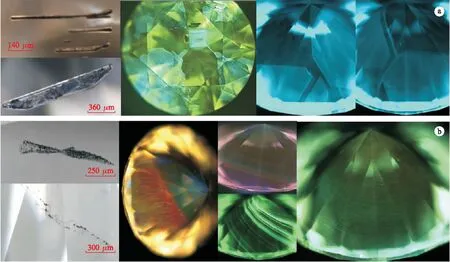
Fig.9(a)On the left, some photomicrographs of the more common inclusions seen in HPHT-grown diamonds are pictured.These often include thin metallic rods.Also shown are some common observations of deep UV fluorescence imaging.In fancy-color diamonds, a variety of colors may be seen.However, in colorless to near-colorless HPHT diamonds, the deep UV fluorescence images are consistently a greenish blue color.(b)On the left, some photomicrographs of the more common inclusions seen in CVD-grown diamonds are pictured, which often include pinpoints or clouds of non-diamond carbon.Also shown are some common observations of deep UV fluorescence imaging.In CVD diamonds, even for those are colorless to near-colorless, there is a wide variety of possible fluorescence colors due to the growth conditions and possible post-growth treatments.Often the patterns seen in CVD diamonds will consist of obvious growth layers(center images)or striations(far right).
ADVANCED TESTING METHODS
The spectroscopic features of laboratory-grown diamonds, particularly those detected by photoluminescence(PL)spectroscopy have been well established(Wang et.al., 2012; D’Haenens-Johansson et al., 2014; Eaton-Magaa and Shigley, 2016; Eaton-Magaa et al., 2017).Here, some of the more recent developments regarding spectroscopic results are recounted.
For many years, the detection of the SiV-peak at 736.6/736.9 nm has been a reliable marker of CVD-grown diamonds.Recently, the GIA laboratory has begun seeing a small percentage of CVD diamonds containing a very weak or undetectable SiV-feature.The proportion of CVD diamonds without a SiV-peak may increase in the future, thus decreasing its relevance as a reliable diagnostic feature and illustrating the need to look at all gemological and spectroscopic evidence to form a correct identification.
Some new methods of analyzing laboratory-grown diamonds have emerged of late.These include Raman and PL mapping which allows the ability to quickly gather PL spectra across the surface of the diamond and create a map of PL intensities(Eaton-Magaa et al., 2021).Thousands of spectra can be collected automatically in less than five minutes while the stone is at liquid nitrogen temperature(-196 ℃).The pixel size of each collected spectrum can be a few microns.Fig.10 shows examples of PL mapping of the SiV-defect that can appear very differently in CVD-grown and HPHT-grown diamonds.
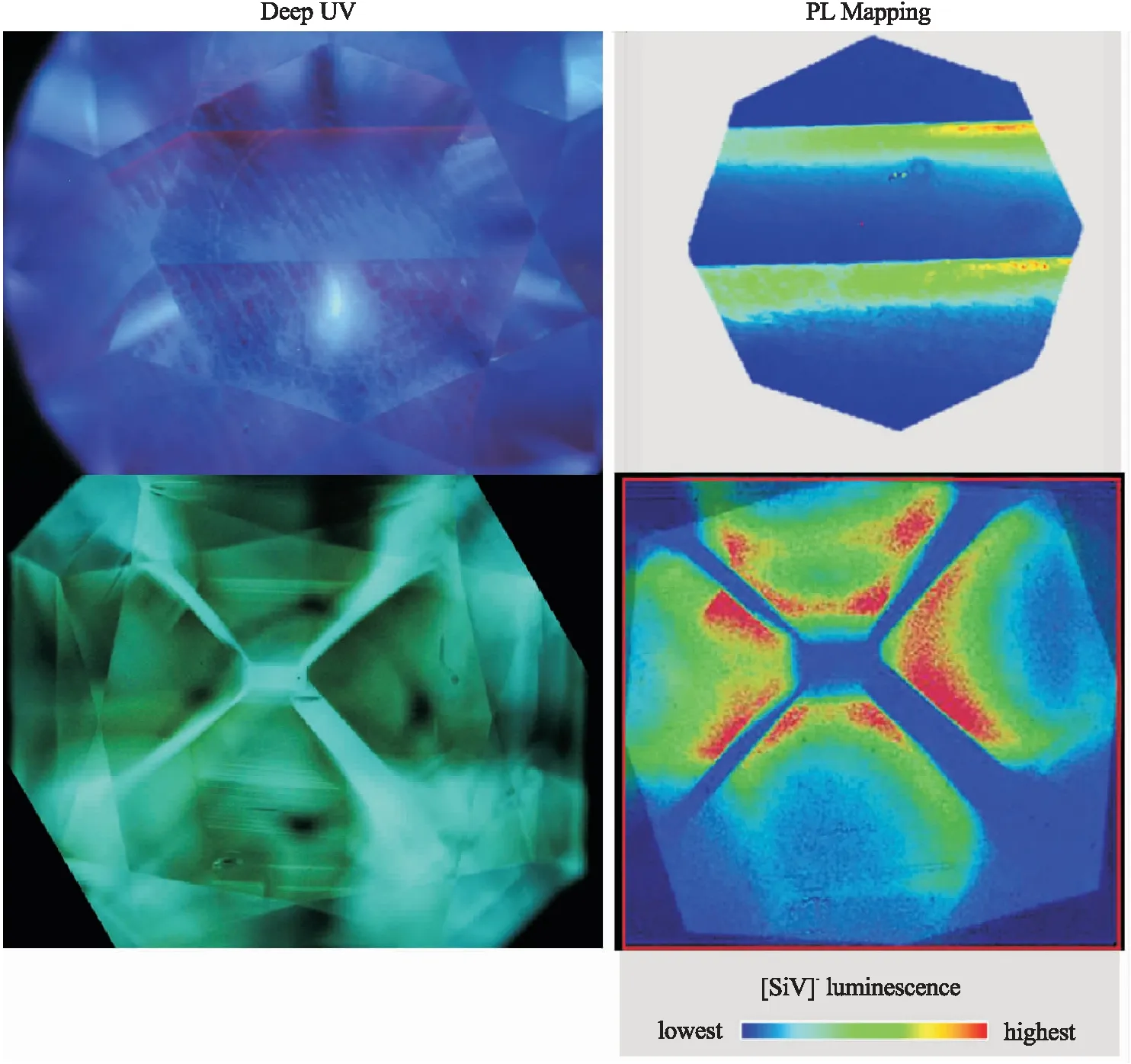
Fig.10(top)This 3.23 ct, I-color, as-grown CVD diamond is presented with the results for the deep UV fluorescence imaging and the results for PL mapping of the table facet using 532 nm excitation and with the diamond submerged in liquid nitrogen.This sample shows multiple grown layers with SiV- showing the highest concentrations near the growth interfaces(Dieck et al., 2015).(bottom).This 0.42 ct Fancy Deep green, treated HPHT diamond shows the different growth sectors by deep UV fluorescence imaging and PL mapping using 633 nm excitation and liquid nitrogen.The SiV- concentration is confined to the {111} growth sectors(Johnson and Myagkaya, 2017).
UNUSUAL LABORATORY-GROWNDIAMONDS
GIA occasionally encounters laboratory-grown diamonds that we consider as unusual.Some of these rare examples are described here as such presently distinctive stones may become more common in the future.
TypeⅡbCVDDiamonds
Recently, GIA has observed that a small, but noticeable percentage of CVD-grown diamonds are being submitted with detectable boron in their IR absorption spectra and they are classified as type Ⅱb.For many years, colorless HPHT-grown diamonds have shown low boron while CVD diamonds were generally type Ⅱa.The CVD-grown type Ⅱb diamonds were quite rare.Currently, however, about 5% of CVD diamonds and more than 75% of HPHT-grown D-to-Z diamonds have detectable boron; this is usually at low concentrations of~30 parts per billion.These concentrations are generally not sufficient to affect color.Among CVD-grown diamonds, the vast majority of those that are type Ⅱb have been submitted within the last year.
CVDOvergrowthonNaturalDiamonds
In 2017, GIA encountered its first example of client-submitted CVD overgrowth on a natural diamond(Fig.10a; Moe et al., 2017).GIA had researched this eventuality for years previously and therefore recognized its origin.In this material, the grower places a faceted natural diamond,(rather than the standard HPHT-grown diamond)into the CVD reactor as the seed plate, with both components retained in the faceted gem.The intention of such hybrid diamonds is either to add weight to a diamond(e.g., Tang et al., 2018)or to achieve a color change(e.g., Moe et al., 2017).
There is a limit on the thickness of the CVD overgrowth layer when deposited on a faceted natural diamond.For example, in order to minimize non-diamond growth during the CVD process, very high-purity HPHT synthetics cut within 2oof the cube {100} direction are used as seed plates(Berdermann et al., 2004).The surfaces of a faceted diamond would deviate significantly from that desired {100} direction, limiting the potential thickness of a deposited CVD layer.This implies that only minimal weight can be added and that the table facet is the most likely growth face for such instances of CVD overgrowth(e.g., Tang et al., 2018).
For CVD overgrowth intended to impart a blue color with a layer of boron-doped CVD-grown diamond, only a very thin film is necessaryto have a dramatic effect on the stone’s color.However, gemological examination clearly and conclusively showed the color origin of such submissions, which were identified to the client as “Synthetic”.Fig.11a shows a deep-UV fluorescence image that shows the distinct boundary between the CVD and natural layers(Moe et al., 2017).To our knowledge, less than a handful of these CVD overgrowth diamonds(whether to introduce a bluish color or to add weight)have been discovered and reported among all gemological laboratories in the years since(Moe et al., 2017; Tang et al., 2018; Ardon and McElhenny, 2019).Nevertheless, they remain a concern as standard screening equipment for laboratory-grown diamonds do not detect such hybridmaterials.
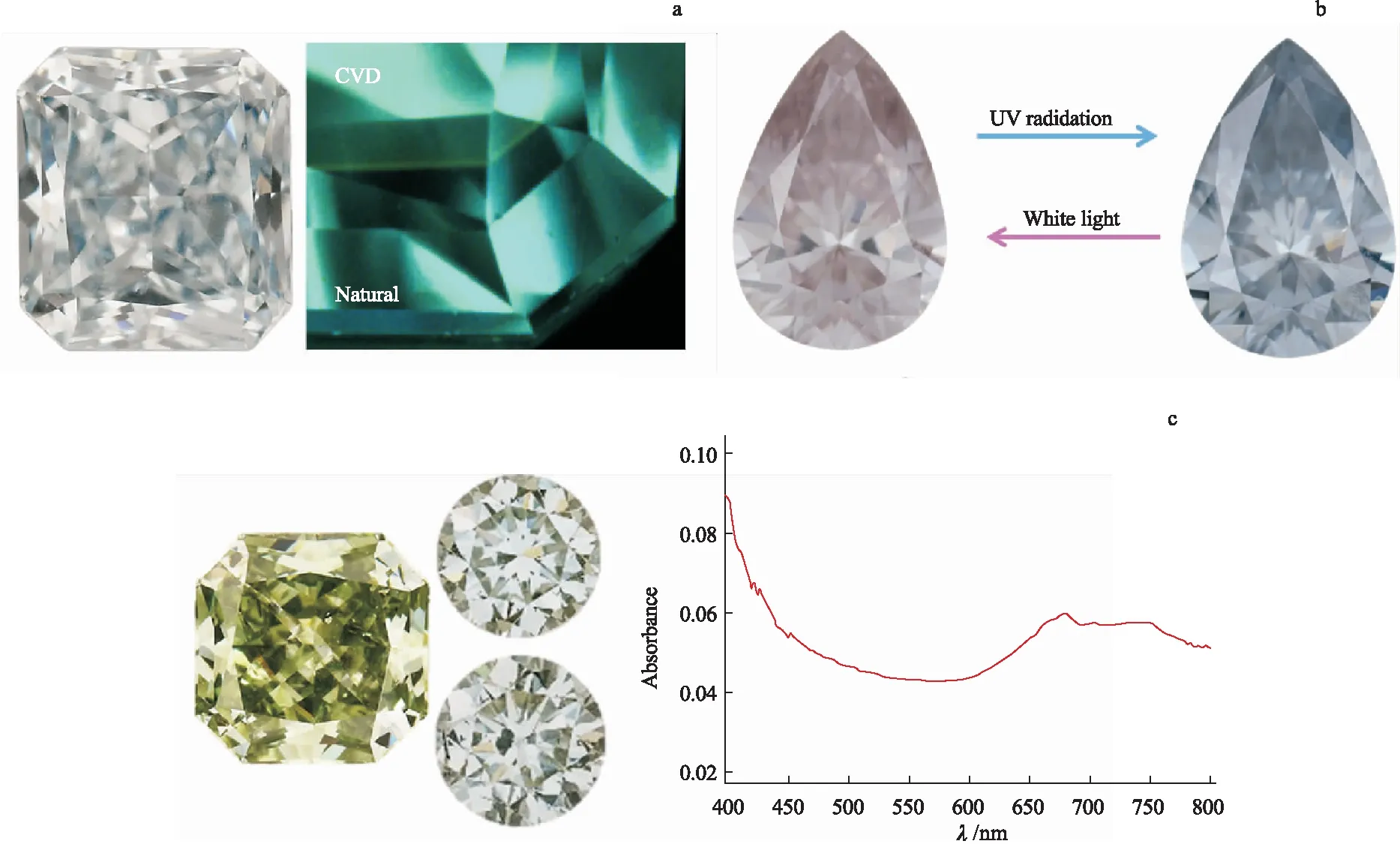
Fig.11 (a)This 0.33 ct Fancy blue diamond has a CVD-grown layer which is 0.08 mm thick and adds approximately 0.01 ct of weight(Moe et al., 2017).The interface between the natural and CVD layers is obvious when observed by deep UV fluorescence imaging.(b)This 0.65 ct CVD-grown diamond has Fancy brown-pink as its stable color, but converts to a Fancy Intense blue with deep UV excitation.(c)A 0.42 ct Fancy Deep green, 0.47 Faint yellow-green, and a 0.51 ct very Light green HPHT-grown diamonds(clockwise from left)received their color from high amounts of nickel doping.At right is the visible-NIR absorption spectrum for the 0.51 ct very light green HPHT-grown diamond(Johnson and Myagkaya, 2017; Eaton-Magaa, 2019).
Color-ChangeCVD-GrownDiamonds
With CVD growth, manufacturers can create distinctive products that are simply not possible within natural diamonds.For example, intentional doping with massive amounts of silicon generally creates a dominant absorption feature at 737 nm due to the SiV-defect, which has not yet been observed in the absorption spectra of a natural diamond.When the silicon concentration is sufficiently high, then the resulting CVD diamond has a pinkish-brown to pink appearance.This is the CVD diamond’s stable color.However, by illuminating the stone with UV, it is possible to temporarily increase the concentration of SiV0centers, which show principal absorption and emission at 946 nm within the infrared.The charge transfer from SiV-to SiV0will introduce a blue color(Fig.11b; D’ Haenens-Johansson et al., 2015b; Breeze et al., 2020), but this change is temporary and will revert back to the stable color with exposure to white light.Due to this possible color change from an unstable blue back to the stable color of pinkish brown, the color stability of blue or gray CVD diamonds should be confirmed by exposure to white light.This type of diamond can also undergo a different color change by heating.When heated, electron donors will transform SiV-into SiV2-which has no optical absorption(Breeze et al., 2020).The heating can make the pinkish brown diamond appear colorless.This is a temporary change and the diamond will return to its stable color as it cools and with white light exposure.
Stable blue colors are also possible by silicon doping in CVD-grown diamonds.If the nitrogen isminimized and the diamond is heavily silicon doped, then the predominant defect will be SiV0and blue color can be obtained.
Another type of unrelated reversible color change is also observed in CVD-grown diamonds.The stone can become browner in appearance if exposed to UV or it can become noticeably less brown(i.e., more colorless)if heated to temperatures of >450 ℃(Khan et al., 2010).These color changes are temporary and reversible, but the unstable color can be maintained if the stone is kept in the dark or within opaque stone papers.Likely, this color change is seen in more CVD diamonds than the SiV-→SiV0mechanism.For these diamonds, the cause has been ascribed to electron transfer from isolated nitrogen atoms to electron acceptor defects(Khan et al., 2009)such as NVH(a defect that shows IR absorption at 3 123 cm-1and which can be detected in some as-grown CVD diamonds).As with the SiV-→SiV0color change, the stable color can be restored with white light.
High-NickelHPHT-GrownDiamonds
Recently, there have been some other attractive options of HPHT-grown diamond.These have incorporated high amounts of nickel to create an attractive green color(e.g., Johnson and Myagkaya, 2017).The resulting green coloration is quite distinct in appearance compared to laboratory-grown diamonds that were colored green by irradiation after growth.By doping with high amounts of nickel, they create an absorption band within the red, centered at about 685 nm thus forming a transmission window within the green(Fig.11c).Only a few examples with deep green coloration have been submitted, but we have seen many with Faint to Fancy light green colors due to nickel(Eaton-Magaa, 2019).Some natural diamonds have a greenish color due to nickel impurities, though often at far lower concentrations than these lab-created versions.Additionally, the nickel-bearing natural diamonds often have nitrogen-related defects that combine to impart a green-yellow color instead.
CONCLUSION
In the last few years, a more complete description on grading reports regarding laboratory-grown diamonds has taken on new importance within the trade.Therefore, many gemological laboratories now provide, in addition to complete descriptions of the stone’s quality factors, both the growth method(whether CVD or HPHT)and whether the stone shows evidence of post-growth treatment.
Additionally many companies have committed to a high amount of capital investment for their laboratory-grown diamond factories(Lu et al., 2019; DeMarco, 2020)and created advertising that could lead to these stones being viewed as a commodity product with an abundant supply available on the market(e.g., Lu et al., 2019; Bates, 2021).Whether this emerging market supplements or usurps portions of the natural diamond market remains to be seen.
If submissions to GIA are an adequate proxy for materials available on the market(not including melee), then Fig.4 and Fig.5 illustrate that the laboratory-grown diamond market has significantly shifted towards colorless and near-colorless goods.There are some exceptions, however, such as the treated fancy colored laboratory-grown diamonds offered by some producers(e.g., Bates, 2021).
Both HPHT and CVD growth are quickly evolving due to the goal of manufacturers to create new products for both engineering applications and for gem purposes.The quantity of stones, the range of colors, and the sizes will continue to increase in the coming years.
Among HPHT-grown diamonds, those at the extreme ends of the weight scale,both melee-sized and larger samples greater than 4 carats, will likely increase the most in quantity.CVD diamonds, at the commercial sizes, are submitted at much higher quantities than their HPHT-grown cousins and this trend will likely increase in the coming years.
The gemological and spectroscopic properties described in this article illustrate that laboratory-grown diamonds are quite different from their natural counterparts and that HPHT-grown and CVD-grown are quite distinct from each other.Therefore, despite the rapid evolution over the last decade, which will surely continue in the future, laboratory-grown diamonds examined by GIA are readily identified.

